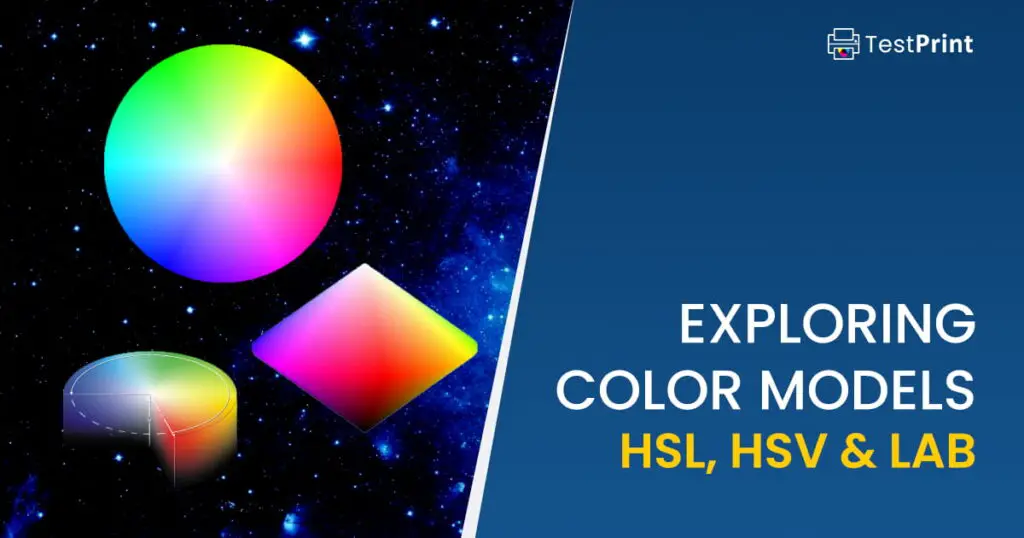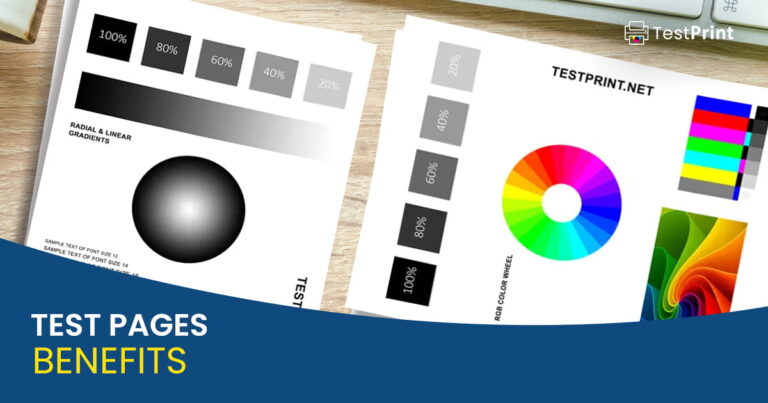Akin to the adage that paints a thousand words, colors uniquely express a broad spectrum of emotions, nuances, and meanings in ways that transcend language. The depth and breadth of colors are encapsulated in color models, the unsung heroes behind the vibrant worlds of graphic design, photography, television, and printing. These models do more than offer a dazzling array of shades and hues; they represent an intricate science that combines art, perception, light, and technology. We will traverse through the nuances of HSL (Hue, Saturation, Lightness), HSV (Hue, Saturation, Value), and Lab (Lightness, a*, b*) color models, to understand their unique processes, differences, and applications.
Understanding the Basics of Color Models
Understanding the Basics of Color Models
A color model, often referred to as a color coordinate or color space, serves as an abstract mathematical framework that identifies colors in a way that replicates how humans perceive them. Essentially, a color model provides the means to describe and classify colors using numbers.
These color models are important across a wide array of industries. For instance, graphic designers use them to ensure designs maintain color consistency across various mediums. In photography, professionals leverage color models to manipulate and improve a photograph’s colors, hues, and tones effectively. Equally, in the television industry, color models help in color grading, a process of altering and enhancing the colors in a video scene. In printing, color models play a vital role in accurately duplicating digital colors in a print format – one which might look different due to the materials and processes used.
There are two main categories of color models: additive and subtractive. Additive color models, such as RGB, involve color mixing of light. Here, the colors red, green, and blue form the basis, and when combined, they can create any desired color. Furthermore, when all these colors are mixed, the resulting color is white. This model aligns with the way screens display colors.
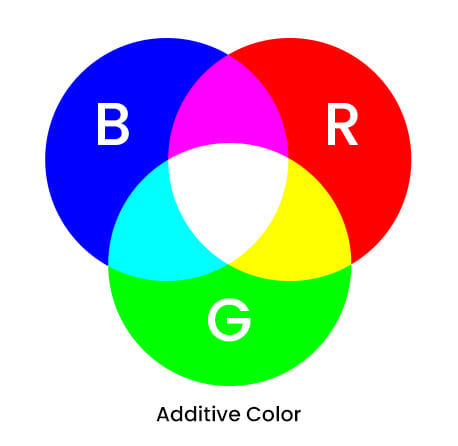
On the other hand, subtractive color models like CMYK work by color mixing of dyes, inks, or pigments. The model starts with white, and colors subtract (or absorb) certain color wavelengths, hence “subtractive.” This model is typically used in printing.
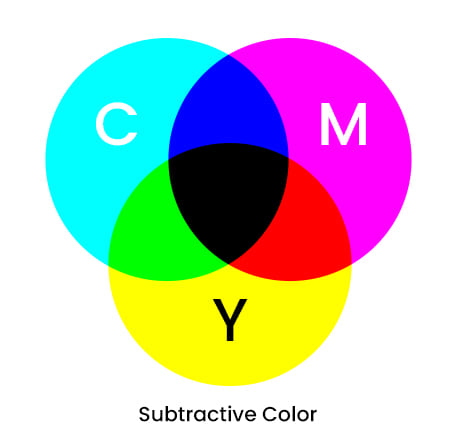
HSL: Hue, Saturation, Lightness
HSL stands for hue, saturation, and lightness. The HSL color model is designed to be more intuitive and closer to the way humans perceive and interpret color.
Hue signifies the type of color (red, blue, green, etc.) and its position on the color wheel. Saturation refers to the intensity or purity of a color. A higher saturation level means the color is more vibrant, while lower saturation levels make the color more dull or gray. Lightness represents the amount of white or black mixed with a color. At 50%, there is no white or black added, and the color is neither too light nor too dark.
HSV: Hue, Saturation, Value
Also known as HSB (Hue, Saturation, Brightness), the HSV color model is quite similar to HSL. The ‘value’ in HSV stands for the brightness of the color. One key difference between these two color models is that adjusting the lightness in HSL affects the color’s perceived brightness or darkness, while shifting the value in HSV impacts the color’s intensity – how white or black the color appears.
Lab: L*, a*, b*
The Lab color model, also known as CIELAB, is a perceptually linear color space. Here, ‘L’ represents lightness, ‘a’ specifies the color’s position between green and magenta, and ‘b’ denotes the color’s position between blue and yellow. This model is unique because it aims to emulate human vision and can perceive colors the way the human eye does. Additionally, it’s designed to be hardware-independent, which means colors shouldn’t shift when viewed on different devices.
HSV, HSL, and Lab are distinct color models each adopting a unique approach to measure and decipher colors. By fully understanding the intricacies of these models, professionals in diverse areas such as website design, art creation, photo editing, and various visual media creation can make well-informed decisions to excel in their respective fields.
In-Depth Look at HSL (Hue, Saturation, Lightness)
Delving Deeper: HSL (Hue, Saturation, Lightness)
Firstly, we have the HSL color model, an intuitive system that visualizes color in the form of a circular cone or a double cone -depending on one’s preference. The HSL, shorthand for Hue, Saturation, and Lightness, finds its application within varying sectors. It pervades computer graphics, web designs, data visualizations, and much more.
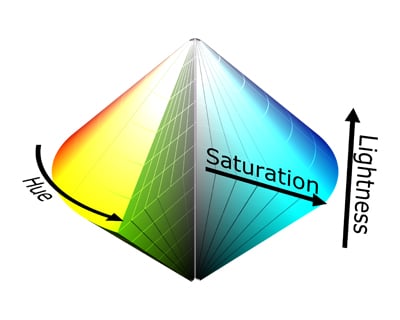
The Role of Hue
Hue represents the main quality of color, i.e., the redness, blueness, greenness, etc., and it’s denoted by an angle. In HSL, the Hue is measured in degrees from 0° to 360°. The wheel starts from red at 0° and goes through green at 120°, and blue at 240° before looping back to red at and above 360°.
Impact of Saturation
Saturation represents the vibrancy of the color, ranging from a pure, saturated color at 100% to a washed-out, grayish color at 0%. For any given lightness, a color’s saturation determines how muted or vibrant the color is.
Understanding Lightness
Lightness, also sometimes referred to as luminance, determines how much white or black is mixed in with the color, essentially describing the color’s brightness. At 0% lightness, regardless of the hue and saturation, the result is black. At 100% lightness, the outcome is white. The more lightness a color has, the closer it moves towards pure white.
HSL vs HSV
While some use HSL and Hue, Saturation, Value (HSV) interchangeably, they depict colors differently despite their common representation in a cylindrical geometry. HSV characterizes color similarly to how humans perceive it, with Hue and Saturation having the same meaning as in HSL.
The difference lies in the V or Value component. While Lightness in HSL attempts to depict a more linear brightness step, Value in HSV adds an intensity element, resulting in brighter colors for the same saturation and hue. The brightest (and often least colorful) variant is at the top of the HSV model, while in HSL, pure, vibrant color is at the middle lightness, with white at the top.
HSL vs Lab
The Lab color model, also known as CIELAB, is another approach to capture human color perception, originating from the global standardization body for color communication, the International Commission on Illumination (CIE). It’s designed to approximate human vision and is device-independent – it’s not reliant on a specific device’s color capabilities.
Lab separates the color into three components: L* for the lightness from black (0) to white (100), a for the color spectrum from green (-) to red (+), and b for the color spectrum from blue (-) to yellow (+). Unlike HSL that requires hue rotation to traverse colors, colors in Lab can be traversed by merely changing these a and b coordinates.
In terms of comparison to HSL, Lab has a higher perceptual uniformity – color differences in images are closer to visual differences. HSL has a simpler conceptual model and is often more intuitive for users, but Lab provides a more accurate representation of human vision.
Wrapping Up
Each color model — HSL, HSV, and Lab — provides a distinctive form of color representation and suits different applications. The choice of one over the others primarily leans on the specific requirements of your project or task.
Understanding HSV (Hue, Saturation, Value)
Diving into HSV (Hue, Saturation, Value) – A Broad Overview
Altering the course from the traditional Red-Green-Blue (RGB) color model, the HSV color model, an abbreviation for Hue, Saturation, and Value, evolved as a non-linear additive color model. It sought inspiration from both theoretical and physiological facets of color perception to formulate a more perceptual approach to color representation. This intuitive approach considerably simplifies tasks such as image analysis, manipulation, and digital graphics, enhancing user-friendliness.
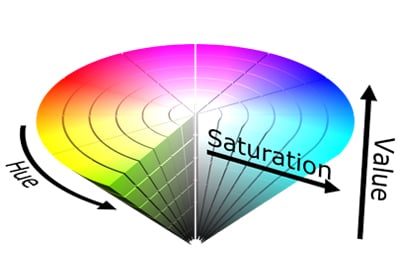
Hue, Saturation, and Value: The Pivotal Components of HSV
At the heart of the HSV color model are three essential parameters: Hue (H), Saturation (S), and Value (V).
- Hue (H): Hue represents the color type and is usually represented as an angular dimension where each angle corresponds to a color: 0° (or 360°) for red, 120° for green, and 240° for blue.
- Saturation (S): Saturation, described in terms of percentage, represents the intensity of a hue. A lower saturation level leads to less vibrant colors, with 0% saturation resulting in shades of grey. On the flip side, 100% saturated hue represents the pure, vibrant version of a color.
- Value (V): The Value, also described as a percentage, signifies the brightness of a color. A color with 0% value will always be black, while a color with 100% value will have the brightness of the color depending on the saturation.
The Distinction Between the HSV and HSL Color Models
The HSL (Hue-Saturation-Lightness or Hue-Saturation-Luminance) color model and the HSV model differ mainly in the representation of color brightness, with lightness taking the place of value in HSL.
In the HSV model, the color’s brightness or ‘value’ increases vertically from black to white, with the most vibrant colors appearing at the top of the cylinder. In contrast, the HSL model represents brightness differently. It goes from a minimum at the bottom, increases to a maximum in the middle (pure colors), and then decreases again toward the top of the cylinder. This structure allows for more accurate shading and tinting control.
How the HSV Model Finds Its Application
The HSV model shines when it comes to digital environments, where it finds its major applications. With a design inspired by human perception of colors, it offers a more intuitive way to select colors in digital graphics and image editing software. This model’s structure allows users to adjust the hue (tint), saturation (shade), and value (tone) independently, thus providing finer control over the color output.
Notably, in digital image analysis, the HSV model aids in image segmentation, feature extraction, image description, and object recognition. It is especially useful in scenarios where color description plays a key role, such as in skin detection, vegetation detection, and even traffic signal recognition in autonomous vehicles.
Comparing HSV and Lab Color Models
The HSV color space and Lab color space each have their unique attributes, making them ideal for different applications. Unlike Lab, which is a perceptually linear color model designed to approximate human vision, HSV is a non-linear color model. Thus, Lab excels when color accuracy and differentiation are pivotal, such as in photography and printing. Conversely, HSV shines in contexts involving digital graphics and image processing where color manipulation and intuitive color selection is key. In the Lab model, we can dictate color through three dimensions: lightness, and two chromaticity dimensions that represent red-green and yellow-blue color opponent pairs.
Still, there is no one-size-fits-all model; HSL, HSV, and Lab each bring their strengths and weaknesses to the table. So comprehending the nuances of these models aids in choosing the most suitable one for your specific need.
Demystifying Lab (Lightness, a*, b*)
Diving Deeper into the Lab Color Model
Commonly known as L*a*b* or CIELAB, the Lab color model is a perceptual color space, built to approximate human vision. This color model is the brainchild of the International Commission on Illumination (CIE) who aimed to construct a mathematical representation of colors as they are perceived by the human eye. Over time, it has been recognized as a highly comprehensive model, capturing the entire spectrum of colors that the human eye can discern.
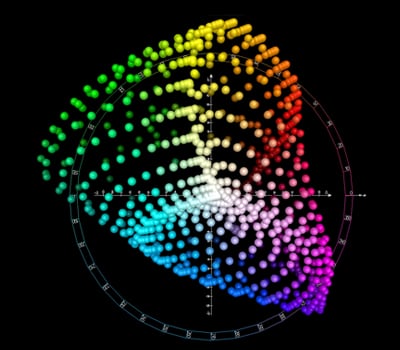
The Three Dimensions of the Lab Color Model
The three dimensions in the Lab color model each refer to a different aspect of color perception:
- Lightness: The L dimension stands for Lightness and ranges from 0 to 100, with 0 being black and 100 white. The ‘L’ dimension directly corresponds to perceived lightness and is, therefore, straightforward in its applicability.
- a*: The a* dimension scales from green to red, in terms of color opponents. Negative values of a* represent green while positive ones represent red. Thus, ‘a*’ captures all the nuances between these two color extremes.
- b*: The b* dimension scales from blue to yellow. Like a*, negative values in this dimension represent blue and positive values represent yellow. ‘b*’ hence captures all the colorations from a deep blue to a sunny yellow.
Usage of the Lab Color Model
Unlike RGB, HSL, or HSV color models that are typically used for displaying colors onscreen, Lab is more frequently used in color science and color difference calculations, making it especially useful in industries such as printing, photography, and textile manufacturing.
Lab offers superior accuracy when it comes to representing color differences as perceived by the human eye, which is why it’s often utilized in applications that require precise color matching or detection of subtle color differences. For example, determining whether a print has deviated from its original color or identifying minor changes in the color of an art piece due to aging.
Lab vs HSL vs HSV
Contrasted with the HSL (Hue, Saturation, Lightness) and HSV (Hue, Saturation, Value) color models, Lab has several distinct advantages.
Firstly, Lab is arguably the most perceptually uniform color model. This means that a small change in a color value yields a uniform change in color perception, a critical characteristic when accuracy in color differentiation is necessary.
In contrast, both the HSL and HSV models end up distorting the perceived color differences. Hue in both models is a circular value, which makes interpolation and estimation difficult. Moreover, saturation in both HSV and HSL does not align well with human perception, which means these models are often less precise for consistency in color depiction.
Finally, neither HSL nor HSV can represent the full gamut of colors perceivable by the human eye. Only the Lab color model is optimized for this purpose, providing a broader spectrum of color representation, from the most vibrant hues to the subtlest shades.
Overall, while HSL and HSV have their own unique strengths for specific purposes and contexts, Lab offers a more encompassing, accurate, and perceptually consistent color model.
Color models are not simply about splashes of red, mellow yellows or calming blues; they represent an intricate web of light, perception, and technological representation. Through an examination of HSL, HSV and Lab color models, we find distinct methods of representing color that offer unique advantages. HSL’s friendly, artistic approach, HSV’s focus on color intensity, and Lab’s expansive color gamut reflect the varied needs of different industries. Collectively, they symbolize the capacity of color models to evolve with the growing sophistication of our understanding and use of color, paving the way for future innovations and color experiences beyond our imagination.

